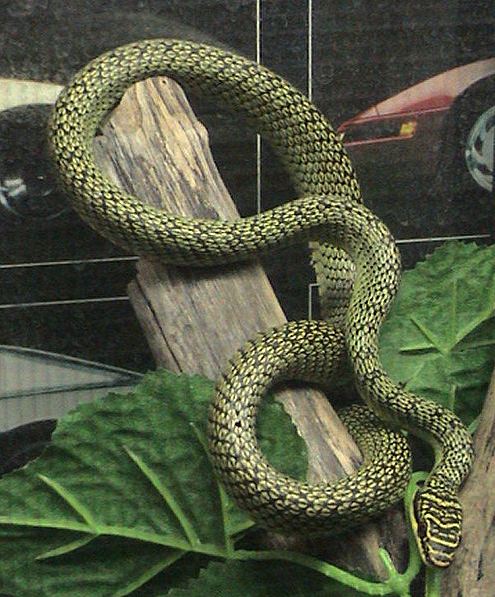Snakes tend to be highly venomous, mildly venomous, or not venomous at all. There are just so many species of snakes around the world that you will simply lose count. One of them is the golden tree snake. Known for its beautiful green and black skin color combination, many people question whether it is dangerous or not. Although it is known to be mildly venomous but researchers have found that it mostly prefers to kill its prey by crushing it and breaking its neck.
Habitat
Gold tree snakes are more accustomed to living on the ground of dry deciduous forests, rainforests, agricultural areas, and rural gardens. The Paradise tree snake is it’s relative and happens to share many similarities. One key similarity they share is that both can glide through the air. Furthermore, golden tree snakes can climb very tall trees and even the walls of buildings. They can mostly be seen climbing coconut palms or vertical rock faces in curves.
Appearance
The golden tree snake tends to have three sub-species. The Chrysopelea ornate features two major colors that depend on the geographic location of the snake. For instance, in Sri Lanka and the southern extent of its Indian range, the snake tends to feature a greenish-yellow or pale green color. Then, there is the second color variety in Southeast Asia that does not feature the reddish vertebral spots and has black crossbars that are less prominent. In addition to that, the head of the snake tends to be flat with a thin neck and a blunt atypical nose. The eyes are also large that can be red depending on the observer’s angle. They can grow upto about 140 cm and are rear-fanged, which means that they will not let their prey go once they have captured it.
Behavior
To answer the question, golden trees snakes are venomous? As mentioned earlier, these snakes happen to be diurnal and despite being mildly venomous, tend to kill their prey by crushing it and breaking its neck. Since they are shy and fast, it is almost impossible to capture them when they come in contact with humans in apartments and homes. Although the snake is commonly found everywhere in SouthEast Asia, they tend to live a solitary life. However, they can also live close to their species without being attacked. As a carnivore, it likes to eat lizards, small geckos, and large Tokay geckos.
Flight
The golden tree snake can not only climb high trees but also glide and parachute as well. It is assumed that the snake does it to cover distances faster, to escape from predators, to catch prey, or to simply move in the forests. Even though flying snakes tend to parachute from trees to trees but sometimes they can parachute to the ground as well.
The golden tree snake glides by first climbing to a certain height by using its keeled belly scales and upon reaching the height, launches itself into mid-air. Once it is in mid-air, the snake contracts its ventral surface to form a U-shaped concave depression along the entire length of the body. This concave surface allows the snake to glide while increasing the air resistance. While gliding, it holds the tail rigidly upwards and attains balance by twisting it from side to side.
Reproduction
Since the golden tree snake is fast, little is known about its reproduction and breeding behavior. However, what is known about the snake is that its mating season is June and it prefers high tree holes and crevices for laying eggs. Furthermore, it is oviparous as it lays 6-12 eggs that hatch in June.
Final Word
The golden tree snakes are venomous, no doubt but their venom is mild and has never caused substantial harm to human life. In Bangkok, golden tree snakes are kept on display outside, in snake pits, and inside the main building on the ground floor. The fact that it is cable of gliding flight makes it a very unique snake specie, and hence can be seen in captivity in zoos as well. However, researchers state that a lot more needs to be learned about the snake in the future.

